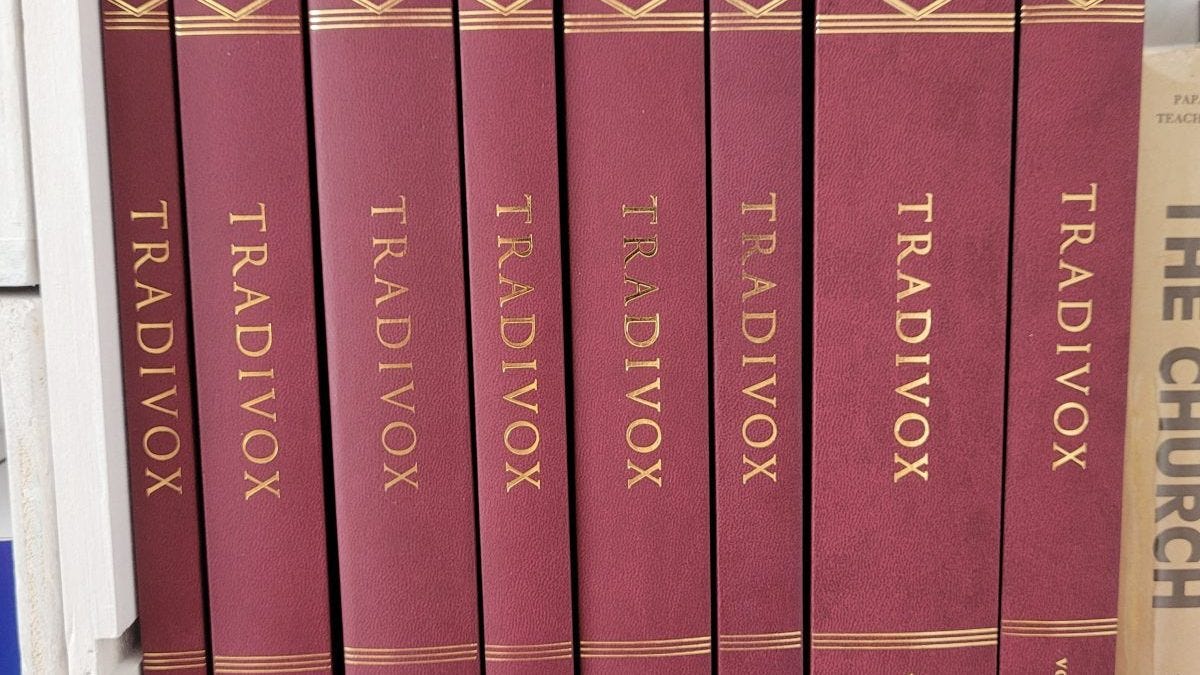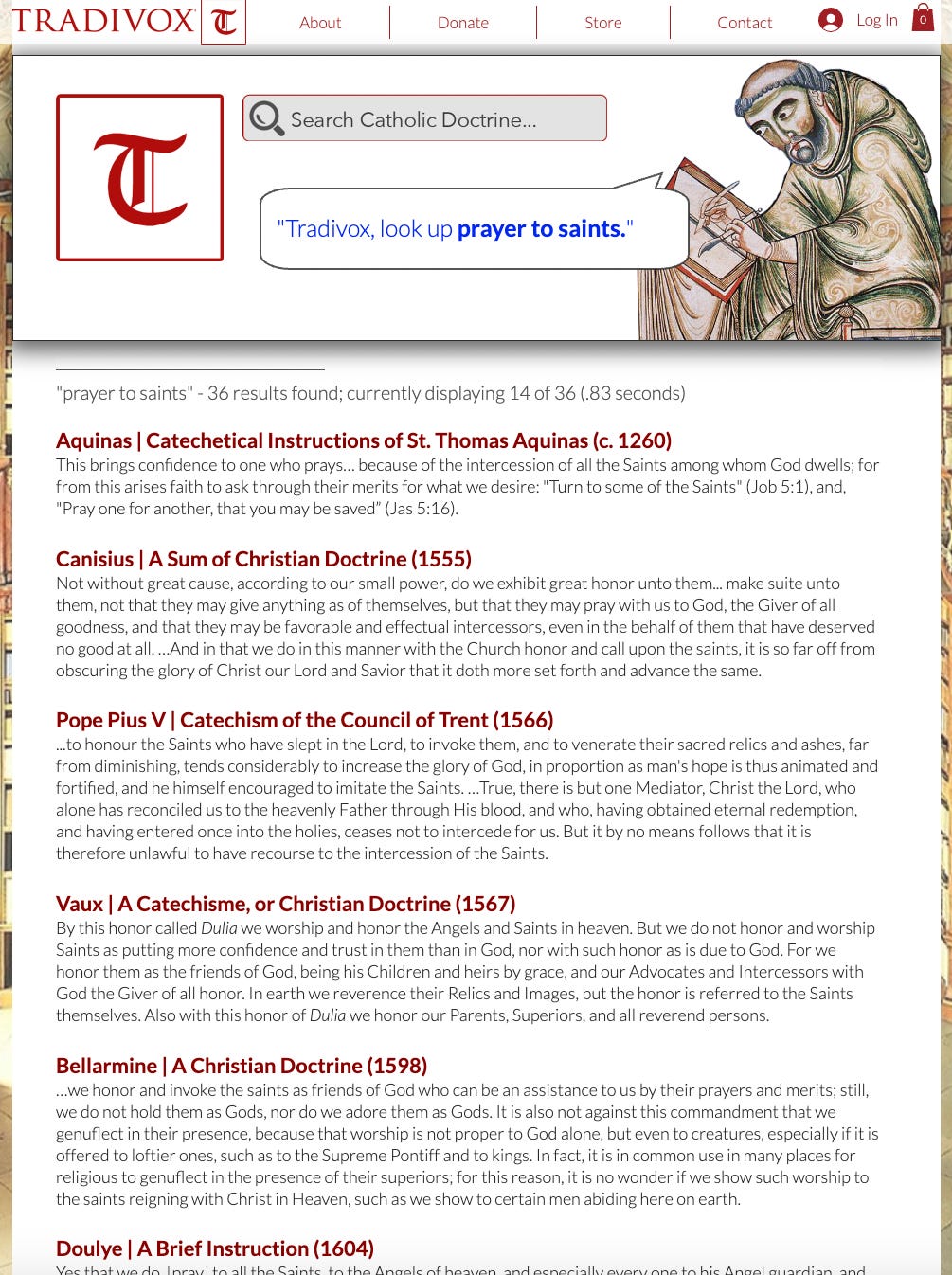How catechisms witness to the universal ordinary magisterium
The humble child's catechism, when it echoes the teaching of the whole body of such catechetical texts, can be an important witness to the teaching of the Church in her universal ordinary magisterium.

What is the magisterium?
The magisterium is a permanent power to teach: this power is exercised by the act of teaching, by those who have received this power.[1] Those who have received this power are the Apostles and their successors (bishops with ordinary jurisdiction) – and not auxiliary bishops, priests or laymen.[2] It is perhaps comparable to the Roman concept of imperium – the supreme power of command, conferred upon certain magistrates.
A bishop’s ordinary magisterium may be exercised in a number of ways – primarily preaching, but also in the act of issuing pastoral letters and local catechisms, or the adoption of theological manuals for the training of seminarians.
Clearly each individual exercise of this ordinary magisterium by an individual bishop is not infallible. However, the body of bishops cannot all fall into error when they teach unanimously teach a point of doctrine, at least when they teach it as divinely revealed. Vatican I taught:
“All those things are to be believed with divine and Catholic faith which are contained in the Word of God, written or handed down, and are proposed by the Church either by a solemn judgment or by her ordinary and universal magisterium to be believed as divinely revealed.”[3]
The theologian Salaverri writes of this text:
“[T]he ordinary way [mentioned at Vatican I] is that in which the Bishops, continuing in community with the Roman Pontiff, exercise the Magisterium while dispersed throughout the world in their own dioceses.”[4]
And this falls in the discussion of the following thesis:
“[T]he way in which [residential] Bishops [collectively and subject to the Roman Pontiff] exercise their own infallibility can be either ordinary, that is, outside of a Council and dispersed throughout the world, or extraordinary, that is, united together in an Ecumenical Council.”[5]
This is a standard doctrine, and not at all unique to Salaverri.
Catechisms and the universal ordinary magisterium
But this can apply not just to theological manuals, but to catechisms. Taken as a whole, the body of diocesan catechisms – whether we take that to mean all those authorised at a given moment of time, or across a long and consistent period, as we see here – can be a standing witness to the content of the teaching of that ordinary and universal magisterium, as well as traditional points of doctrine.
The theologian J.M.A. Vacant teaches that the teachings of the magisterium can be found in the various monuments of tradition, including “the words of the martyrs recounted in their deeds, the inscriptions placed on their tombs,” as well as the creeds and professions of faith. But he adds that the faith of the universal Church may also be found:
“[I]n the Catechism of the Council of Trent and in the whole body of diocesan catechisms, drawn up for the guidance of the clergy of the parishes in the day-to-day instruction of the believers. These are in fact documents in which the Apostles and their successors formulated rules of faith for the faithful, and rules of teaching for pastors, by means of which the unity of doctrine is maintained.”[6]
Diocesan or episcopally-approved catechisms such as those included in this series are a key mode of ordinary teaching. Mgr Joseph Clifford Fenton explains further:
“Catechisms and other approved books of Christian doctrine, in so far as they are adopted by the ordinaries of the various dioceses for teaching the content of the faith to the people of these dioceses may be said to express the ordinary magisterium of the Catholic Church. […]
“The unanimous teaching of these catechisms can rightly be considered by the theologians as an indication of the ordinary and universal magisterium of the Catholic Church.
“The doctrine that is universally or unanimously proposed in these doctrinal books, in such a way that it is presented to practically all of the Catholics of the world as revealed truth, is certainly a verity taught and exposed infallibly in the ordinary and universal magisterium of the Catholic Church.”[7] (Our emphasis and line breaks for clarity)
Some Clarifications
All this said, it’s important not to extend and overstate things.
First, individual local catechisms (or even large selections of them) are not infallible in themselves, and some have in fact contained errors. However, if we can show that all of the catechisms at a given point of history (implying also continuity with past catechisms) unanimously teach a point of doctrine, then we have strong grounds for think that it is a doctrine which we too must (at least) hold (as opposed to “believe).[8]
Second, we should note the qualification – often missed – that the doctrines under discussion are those presented as being a part of revealed truth (and not just any point of doctrine related to faith and morals). If a point of doctrine is taught in a morally unanimous way and specifically “as divinely revealed”, then it can also be said to be “de fide” and thus believed in a proper sense.
What about points of doctrine which are not presented as divinely revealed? Salaverri writes the following:
“898. 10. Of Catholic faith in general is a doctrine which is certainly and necessarily connected with revealed truths and it is proposed infallibly by the Church as something to be believed.
“For, from thesis 17 we know that the indirect object of the infallible act of the Magisterium is truths certainly and necessarily connected with revealed truths.
“Truths of this kind are really proposed by the infallible Magisterium not as things to be believed, because, since they do not pertain directly and formally to the deposit of faith, it is not fully certain that they can be believed with divine faith “because of the authority of God himself who reveals them [D 3008]; however, they are proposed as something to be held, because, on account of their certain and necessary connection with revealed truths, the believer must embrace them with the absolutely certain assent of the mind, in order properly to guard the deposit of the Faith.”[9]
But what if such universally-taught points of doctrine are not clearly presented as being infallibly true, or what if there is some debate over whether they are sufficiently connected with revealed truths? Elsewhere, Salaverri also writes:
“893. Catholic doctrine in general is that which is taught by the universal Magisterium, either infallibly or merely authentically. […]
“[T]he propositions, which thus are proposed generically by the universal Magisterium of the Church, when Theologians do not desire or cannot determine further whether they are taught merely authentically or also infallibly, are wont to say that they are Catholic doctrine in general.“[10]
As such, it would seem fair to say that points which are taught by a moral universality of approved catechisms are at least “Catholic doctrine” in general, if not of a higher value depending on the manner of in which they are proposed.
The Tradivox Series
Projects like the Tradivox Catechism Series certainly allow us to have an indication of what has been taught in a morally universal way over the centuries.
This series is publishing many old diocesan catechisms and the Catechism of the Council of Trent, and will run to 20 volumes including around 30-50 catechisms in total. Some texts will not be printed, but will be kept on a searchable digital platform with all of the others.
This is because the editors – whatever anyone thinks of their positions on the current crisis, or inclusion of prefaces by this or that cleric – voice this very admirable hope:
“[T]hat by offering an accessible, indexed collection of traditional catechisms, the beautiful continuity of doctrine found in such works will stand as a remedy for the confusion and error of our time, and as an enduring testimony to the divine mission of the Catholic Church, forever entrusted to her by Christ.”
The project’s focus is showing the continuity of doctrine in the Catholic Church over the centuries, as manifested in these catechisms. It intends even to make this even more manifest through their “Catechism Search Engine” – which will be a searchable database of all of their texts.
Take a look, for example, at this screengrab from the official Tradivox website, showing how they propose this would work for searching for “prayer to saints”:
The search produces very many more titles and texts than I could fit into this picture, and makes the continuity of doctrine very clear – and is thus a clear witness to the teaching of the Church in her universal ordinary magisterium.
UPDATE - September 2024
A few days after publishing this piece, Tradivox launched a fundraiser for their catechism index, now called 'Master Catechism’.
15. What is the Master Catechism?
The Master Catechism (MasterCatechism.com) is a digital search tool that the Tradivox team has developed to curate answers exclusively from approved Catholic catechisms across the centuries.
16. How does the Master Catechism work?
Using so-called "artificial intelligence" (AI) software programs, this tool correlates terms and detects conceptual relationships across the documents loaded into it. This allows it to quickly distill answers to questions from a wide range of sources, even when identical terms are not used in them—e.g., the phrase "capital punishment" is absent from catechisms before the 20th century, whereas the Master Catechism will reflect the Church's changeless teaching on this subject since the time of the Apostles.
17. Is the Master Catechism the same as a "chatbot"?
No. It is a direct-query research tool, and does not log your questions to respond sequentially. Furthermore, being limited to a set of base documents, it does not comb the entire internet to generate commentary on contemporary figures, current events, etc. It responds with the kind of information one would find in the catechisms themselves.
18. What texts are searched within the Master Catechism?
Summaries of Catholic faith and morals that have been approved by the Church (see Criteria #2 above). Acknowledging the watershed events of the late 20th century, we have tagged all pre-1960 catechisms as "classical," and those published afterward as "contemporary." For research and comparison purposes, users may now view results from either or both categories of texts.1
This fundraiser added two interesting additions which had not previously been announced.
First, Master Catechism will also include Bishop Athanasius Schneider’s Credo catechism (and other “contemporary”) catechisms in its database, and searches will bring up material from such texts, unless they are excluded.
Without getting into details, Schneider’s text represents, among other things, one particular understanding of the current crisis in the Church. This is problematic on two counts: firstly, it necessarily presents his particular view on the crisis as normative; second, and more importantly, much violence must be done to traditional Catholic theology in order to hold to this particular understanding.
The inclusion of “contemporary texts” in the database – texts which one assumes will be selected based on a private judgment that they are faithful to Catholic teaching – marks a significant difference from the Tradivox book project. The original mission for the Tradivox series was “offering an accessible, indexed collection of traditional catechisms.” Its vision statement revolved around historical texts. Consider the following statements:
Vision
Our vision is a day when anyone, anywhere can reach for a simple, concise, and reliable presentation of the Faith of our Fathers, and have it ready to hand in both digital and analog form. We are pursuing this vision through three main goals:
1) Publish a hardback collection of the best historical catechisms.
2) Offer a digital search apparatus curating these timeless texts.
3) Deploy faith study courses derived from the same.2
1. Which traditional catechisms are included in the Tradivox Catholic Catechism Index?
The Tradivox team has recovered scores of different catechisms in English alone (not counting variant editions and multi-volume works), ranging from the late 1200s to the 1950s. If you've heard of it, it's probably on our list. Our intention is to capture all of these digitally, while limiting our premium hardback collection to those catechisms that are of greatest merit.
[…]
3. How are you deciding which catechisms to include in your Index?
We select catechisms for inclusion based on four essential Criteria:
Historical significance
Ecclesiastical approbation
Doctrinal continuity
Public domain
4. Why these four Criteria?
Criterion #1 keeps us focused on works that offer a striking glimpse into our Catholic past, as we tell the "story" of each in our Series Editor's Preface. Criteria #2 and #3 serve our goal of demonstrating the historical continuity of Catholic doctrine across time and space. Finally, Criterion #4 keeps our work "open source" for further research.
5. Will you be republishing the Catechism of the Catholic Church (CCC)?
No. Our Index is limited to static works that have entered the public domain (see FAQ #3 above), typically comprising editions published prior to 1963. Although it was called “a sure norm for teaching the faith" when originally issued in 1992 (see Fidei Depositum, n. 3), the CCC has been revised on several points since then, and still remains in print under active copyright.3
While Tradivox was a project based around pre-conciliar catechisms, it stood as an important resource, outside of the differing understandings of the current crisis in the Church. The book series remains valuable for these reasons, as does the database’ option to exclude contemporary texts. However, the inclusion of a work such as Schneider’s sets a tone which potentially undermines the objectivity of this resource.
The second announcement was that each search will prompt an AI summary of all the catechisms. While AI is a very useful tool, I am not quite sure what to think of its use in this context; and, without “contemporary” texts such as Schneider’s being excluded from searches, may result in misleading summaries.
Conclusion and Case Study
To illustrate the value of the Tradivox project – as it was originally conceived – I previously set out what their catechisms – along with some similar texts – say on the criteria for membership of the Church. It is most interesting to see what these basic catechisms say on this topic, which has regrettably become controversial today.
Here is that case study:
As a final and personal note – there is a lot to be said for the old custom of learning the catechism by memory – both for our own children, and for ourselves.
The catechism contains so much of what we all need to know about the Christian religion. It is like the proverbial magic pool, in which the child can paddle and the elephant can submerge itself.
In particular, the English Penny Catechism is extraordinary in the depths contained in its deceptively simple questions and answers. In my house, we use the 1948 edition.
Further Reading
Tradivox I: Three shorter catechisms
Tradivox II: Three seventeenth-century catechisms
Tradivox III: Three texts by Bishop Richard Challoner
Tradivox IV: Three significant Irish catechisms
Tradivox V: Two by Irish priests in the 1700s
Tradivox VI: Aquinas, Pecham, and Pagula
Tradivox VII: Trent
Tradivox VIII: Pope St Pius X and Frassinetti
Tradivox IX: St Peter Canisius
Tradivox XIV: Deharbe
HELP KEEP THE WM REVIEW ONLINE!
As we expand The WM Review we would like to keep providing free articles for everyone.
Our work takes a lot of time and effort to produce. If you have benefitted from it please do consider supporting us financially.
A subscription from you helps ensure that we can keep writing and sharing free material for all. Plus, you will get access to our exclusive members-only material.
(We make our members-only material freely available to clergy, priests and seminarians upon request. Please subscribe and reply to the email if this applies to you.)
Subscribe now to make sure you always receive our material. Thank you!
Follow on Twitter and Telegram:
[1] Parente writes: “The power conferred by Christ upon His Church and strengthened with the charism of infallibility, by which the teaching Church (Ecclesia docens) is constituted as the unique depository and authentic interpreter of divine revelation to be proposed authoritatively to men as the object of faith for their eternal salvation. […]” Pietro Parente, Dictionary of Dogmatic Theology, Bruce Publishing Company, Milwaukee 1951. 170.
[2] Berry notes: “Priests, catechists, parents, and other are simply witnesses to the teachings of the Church.” (258) Cf. also the discussion on “successors of the apostles,” page 232. E. Sylvester Berry, The Church of Christ, Wipf Stock and Publishers, Oregon, dated 1955.
[3] Vatican I, Dei Filius, Ch. 3, “Concerning Faith”, Dz 1792. Translated by Mr John Daly.
[4] Joachim Salaverri, On the Church of Christ, in Sacrae Theologia Summa IB translated by Kenneth Baker SJ 2015. n. 544
[5] Salaverri n. 547
[6] J.M.A. Vacant, The Ordinary Magisterium of the Church and its Organs, Delhomme et Briguet, Booksellers-Publishers, 1887, Paris 13 Rue De L’abbaye, Lyon 3 Rue De l’Archevêché. Translated by The WM Review, available at https://wmreview.co.uk/2021/08/27/vacant-oum-introduction-chapter-ii/
[7] Mgr Joseph Clifford Fenton, The Concept of Sacred Theology, published as What is Sacred Theology? Cluny Media, Providence RI, 2018. (UK readers) p 118
[8] For more on this interesting topic, see the contributions made by Mr James Larrabee here.
[9] Salaverri n. 898.
[10] Salaverri n. 893.







I was hoping you would mention the Penny Catechism -- and you did! I have been using it with my children (and myself) for years. Simple and beautiful from the first question to the last:
1. Who made you? God made me.
2. Why did God make you?
God made me to know Him, love Him and serve Him in
this world, and to be happy with Him for ever in the next.
....
370. After your night prayers what should you do?
After my night prayers I should observe due modesty in going to bed; occupy myself with the thoughts of death; and endeavor to compose myself to rest at the foot of the Cross, and give my last thoughts to my crucified Saviour.
I first heard of Tradivox on the Mike Church show a few years ago. Then...our CSPV pastor suggested it as well. Great stuff.